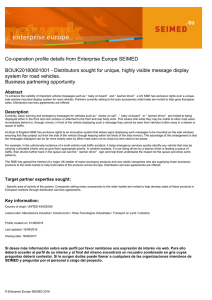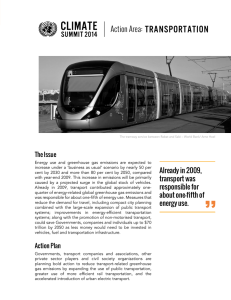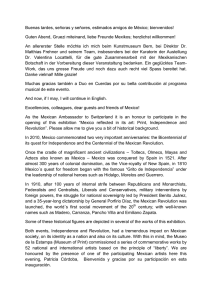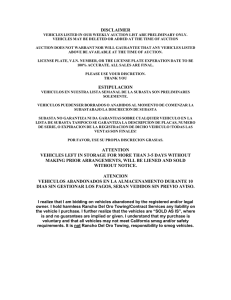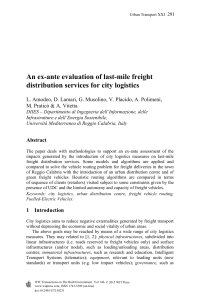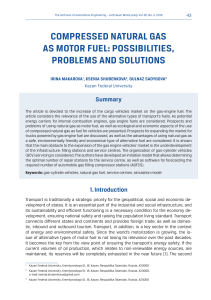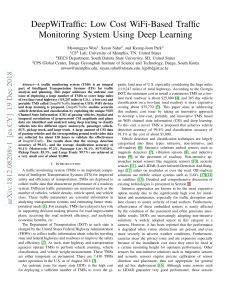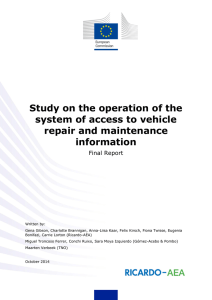Diapositiva 1
Anuncio
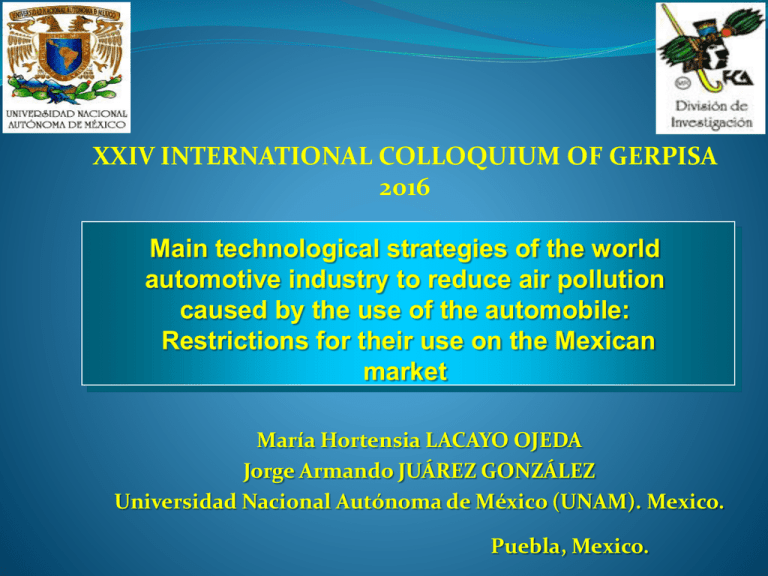
XXIV INTERNATIONAL COLLOQUIUM OF GERPISA 2016 Main technological strategies of the world automotive industry to reduce air pollution caused by the use of the automobile: Restrictions for their use on the Mexican market María Hortensia LACAYO OJEDA Jorge Armando JUÁREZ GONZÁLEZ Universidad Nacional Autónoma de México (UNAM). Mexico. Puebla, Mexico. To analyse the main technological strategies carried out by the world automotive industry to reduce greenhouse gas emissions caused by the use of vehicles To point out the obstacles to generalize such solutions in the Mexican market. CONTENTS General situation of automotive industry in Mexico Mexican vehicle fleet age Greenhouse gas (GHG) emissions in Mexico Technological emissions strategies to reduce automobile GHG Obstacles for electric and hybrid vehicles widespread use in Mexican market THE AUTOMOTIVE INDUSTRY SETTLED IN MEXICO LIGHT VEHICLE PLANT LOCATIONS IN MEXICO HEAVY VEHICLE PLANT LOCATIONS IN MEXICO R & D CENTER LOCATIONS IN MEXICO LIGHT VEHICLE PRODUCTION (2005-2015) 4,000 Thousands of units 3,500 3,220 3,000 2,885 2,933 2012 2013 3,399 2,558 2,500 1,979 2,022 2,261 2,103 2,000 1,606 1,508 1,500 1,000 500 0 2005 2006 2007 2008 2009 2010 Year 2011 2014 2015 Source: Asociación Mexicana de la Industria Automotriz (AMIA). (January 2016). “Producción total” in Boletín de prensa de enero de 2016. Accessed at www.amia.com.mx/descargarb.html on February 20th, 2016. AUTOMOTIVE EXPORTS AND DOMESTIC MARKET (2005-2014) 3,000 120% 2,643 2,423 2,144 1,613 2,000 Thousands of units 1,537 1,186 1,132 1,140 68% 62% 62% 1,223 1,100 1,026 1,000 80% 1,860 1,661 74% 1,500 100% 2,356 95% 755 60% 44% 820 42% 906 1,063 988 42% 1,135 44% 500 Percentage 2,500 40% 43% 20% 0 0% 2005 2006 2007 2008 EXPORTS 2009Year2010 2011 2012 2013 DOMESTIC MARKET DOM/EXPORTS 2014 Source: Graphic drafted with data from Asociación Mexicana de la Industria Automotriz (AMIA). (January 2015a). Exportaciones y mercado doméstico” in Boletín de prensa de enero de 2015. Accessed at www.amia.com.mx/descargarb.html on February 20th, 2015. MEXICAN VEHICLE FLEET AGE 40000 35000 28090 Thousand of vehicles 30000 25000 24091 29565 30351 2009 2010 31830 33154 34731 35890 25770 21476 20000 15000 10000 5000 0 2005 2006 2007 2008 2011 2012 2013 2014 Year Source: Graphic drafted with data from Instituto Nacional de Estadística, Geografía e Informática (INEGI), (January 28th, 2015), Vehículos de motor registrados en circulación in Banco de Información Económica, Mexico. Accesed at http://www.inegi.org.mx/sistemas/bie/? idserpadre=1090053&d10900530#1090053 on February 25th, 2015. 2008: 15 years 2012: 17 years Vehicle fleet is getting older DOMESTIC MARKET AND SECOND HAND VEHICLE IMPORTS (2005-2014) 1,800 1,708 1,600 1,537 1,400 1,140 Thousand units 1,200 1,132 1,100 1,122 1,026 988 1,000 800 1,135 1,063 906 795 820 755 644 597 600 470 458 455 400 240 200 0 70.3% 2005 149.9% 2006 139.8% 2007 109.4% 2008 Domestic market 57.3% 31.8% 2009 2010 65.9% 2011 46.4% 2012 60.6% 2013 40.0% 2014 Years Second hand vehicle imports Source: Asociación Mexicana de Distribuidores de Automotores [AMDA] (January, 2015). Reporte del Mercado Interno Automotor, diciembre de 2014. Accessed in http://www.amda.mx/images/stories/estadisticas/coyuntura/ 2014/Ventas/1412 Reporte_Mercado_Automotor.pdf on February 2015. SECOND HAND VEHICLE IMPORTS 2005-2014 Used vehicles imports have represented 80% of total new vehicle sales from October 2005 to December 2014. 43 % of these vehicles were not mechanical or pollution checked up. GREENGHOUSE GAS EMISSIONS Mexico Sources of greenhouse gas emissions (2010) Not energy related sector 32.60 % Energy production, 33.00% Energy consumption, 34.40% Source: Semarnat, (March, 2014) Registro Nacional de Emisiones. México: Semarnat, figures of INEGI and Semarnat-INECC, accessed at http://www.thepmr.org/ system/files/documents/sesion%205B%20-%20Registro%20de%20Emisiones Mexico_ SEMARNAT.pdf , on June 2nd., 2015. GREENGHOUSE GAS EMISSIONS Mexico Fuel consumption emissions (2010) Residential and agriculture 24.9 MtCO2e 10% Industry and services 57.27 MtCO2e 23% Transport 166.83 MtCO2e 67% Source: Semarnat, (March, 2014) Registro Nacional de Emisiones. México: Semarnat, figures of INEGI and Semarnat-INECC, accessed at http://www.thepmr.org/ system/files/documents/sesion%205B% 20%20Registro%20de%20Emisiones_Mexico_ SEMARNAT.pdf on Jun 2nd., 2015. Technological strategies to reduce automobile GHG emissions Technological options: 1. 2. 3. 4. Alternative energies New types of motors Other technologies Hybrid and electric vehicles ALTERNATIVE ENERGIES BIOFUELS Ethanol or ethylic alcohol (sugar cane, beet, wheat) Biodiesel or Diester (fats and vegetable oils) Biogas or methane gas ALTERNATIVE ENERGIES BIOFUELS USAGE RESTRICTIONS: Biofuels have to conventional fuels. be mixed up to 10% with Specially designed engines are necessary for higher concentrations The agriculture surface area is limited and the crops destined to produce biofuels could compete with food production. ALTERNATIVE ENERGIES BIOFUELS USAGE RESTRICTIONS: Forest areas could be needed to produce them, which could result harmful from the environment point of view ALTERNATIVE ENERGIES LESS POLLUTING FOSSILE ENERGY: Propane or butane (LPG) Natural gas for vehicles (NGV) There are some commercial vehicles that use LP gas in Mexico ALTERNATIVE ENERGIES HYDROGEN It is an ideal fuel for the environment because when it burns, it releases water vapor. USAGE RESTRICTIONS: Automobile cost transformation is 25 000 Euros Special and safe infrastructure is needed for a generalized use. THE ECO INNOVATION IN VEHICLE MOTORS The motor performance influences on the volume of polluting emissions, so as less fuel is used by one motor for a given power, its emissions could be less important. The more cylinders a motor has, the more polluting emissions it will produce. THE ECO INNOVATION IN VEHICLE MOTORS DOWNSIZING The number of cylinders of a motor is reduced, preserving its performance through a turbocharger and a direct injection. FUEL BATTERY It works through gas hydrogen. OTHER TECHNOLOGICAL INNOVATION Catalytic converters Transmissions Driving help systems New assembly technics New materials New designs OTHER TECHNOLOGICAL INNOVATION Vehicle Aerodynamics: reduces the air resistance, which reduces fuel consumption and pollution. THE ECO INNOVATION IN VEHICLE MOTORS HYBRID VEHICLES Their motor combines electrical and mechanical energy of a thermal motorization of fossil fuel. It has fuel savings that go from 4 to 25%. USAGE RESTRICTIONS Vehicle’s high cost Battery cost Hybrid vehicles Model Brand Price MXP Price USA DLLS Tesla Model S Tesla Motors $ 1,387,500 $ 75,000 Prius Toyota $ 339,700 $ 18,362 Civic Hybrid Honda $ 361,900 $ 19,562 BMW i8 BMW $ 2,299,900 $ 124,319 Chevrolet Volt Chevrolet $ 657,800 $ 35,557 ELECTRIC VEHICLES ELECTRICITY Electricity production forms could be nuclear, wind and hydraulic so it could be environmental friendly. USAGE RESTRICTIONS: Urban use; average autonomy from 100 to 150km. Freeway 90km. Complete recharge 8 hrs. Places of quick charge (2 hrs) are needed Electric vehicles Model Brand Price MXPPrice USA DLLS BMW i3 BMW $ 749,000 $ 40,486 Nissan Leaf Nissan $ 545,400 $ 29,481 Spark EV 2015 Chevrolet $ 399,000 $ 21,568 Are electric and hybrid vehicles affordable in Mexican market? Vehicle demand in Mexico Source: Asociación Mexicana de Distribuidores de Automóviles [AMDA] (January, 2016), Reporte del mercado interno automotriz, diciembre de 2015. Accessed in http://www.amda.mx/images/stories/estadisticas/coyuntura/2015/ ventas/1512Reporte_Mercado_Automotor.pdf?utm_source=Boletin+413&utm_campaign=Boletin+413&utm_me dium=email on February 12th, 2016. Source: Asociación Mexicana de Distribuidores de Automóviles [AMDA] (January, 2016), Reporte del mercado interno automotriz, diciembre de 2015. Accessed in http://www.amda.mx/images/stories/estadisticas/coyuntura/2015/ ventas/1512Reporte_Mercado_Automotor.pdf?utm_source=Boletin+413&utm_campaign=Boletin+413&utm_medium =email on February 12th, 2016. MOST WIDELY SOLD AUTOMOVILE PRICES GM Aveo $ 149,900 Spark Nissan LS $123000 LTZ $198,100 Tsuru $ 140,700 Versa Versa Sense $ 222,500 Versa Exclusive $ 222,500 Sentra 2.0 Nissan Sentra Sense $ 236,800 $ 324,400 Startline transmisión manual $ 169,900 Highline transmisión triptonic $ 229,900 $ 229,900 $ 356,940 MT Nissan Sentra Exclusive Volkswagen Vento Nuevo Jetta Volkswagen Jetta 2.0 Manual Volkswagen Jetta TDI AUTOMOVILE PRICE COMPARATION MOST EXPENSIVE FOSSIL FUEL AUTO Volkswagen JettaTDI $ 357 000 CHEAPEST ELECTRIC AUTOMOVILE Chevrolet Spark EV $ 399 000 CHEAPEST HYBRID AUTOMOVILE Toyota Prius $ 340 000 CONCLUSIONS Automotive industry is a very important activity for Mexican economy. Fuel automobiles produce the most greenhouse gas emissions during their use phase. Research and Development strategies have been implemented by automotive industry in order to mitigate these emissions. CONCLUSIONS Electric and hybrid vehicles are environmental friendly There is a lack of infrastructure for electric vehicle use in México Hybrid vehicles are the most possible option for Mexican market CONCLUSIONS Electric and hybrid vehicles are unaffordable for most Mexicans There are important restrictions for their use in Mexican market ¡Gracias! Thank you! Vielen Dank! Merci beaucoup!
